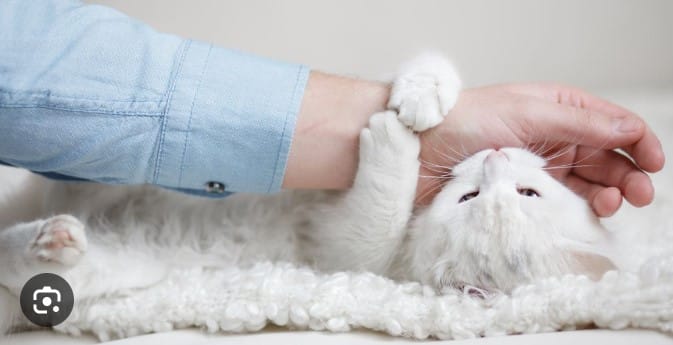Have you ever noticed your cat being both sweet and a little nippy? It’s a confusing thing that many cat owners wonder about. This article,” Why Does My Cat Lick Me Then Bite Me?” explores why cats act this way. We’ll look at the Social Dynamics of Cats and Common Cat Behaviors. As well as the Lick-Bite sequence and Factors Influencing Behavior. Let’s uncover why your cat does these interesting things together. Come along as we figure out why our furry friends show affection mixed with a bit of playfulness.
Cats have always fascinated people because of their mysterious personalities and love for independence. They show many different behaviors that can be cute or confusing. Before we talk about why cats lick and then bite, it’s important to understand their behavior in general.
See also: Are Cats Smarter than Dogs?
Social Dynamics of Cats
Cats are usually seen as animals that like being alone, but they actually have interesting ways of being social that are different from dogs. Even though they don’t act like a group, like dogs do, they still have their own way of making friends and hanging out together, whether they’re in the wild or living with people at home.

Cats in Nature
Out in the wild, cats often live alone. But some types, like lions and cheetahs, hang out with others sometimes. Lions live in groups with their families, called prides. Cheetahs might team up with other cheetahs to hunt.
See also: Can a Dog Get a Cat Pregnant?
Importance of Social Bond
Even though cats can handle being alone, they still like having other cats around. In homes with more than one cat, they might have their own rules and ways of getting along. Some cats might be in charge, while others just go with the flow.
How Cats Talk to Each Other
Cats don’t use words like we do. Instead, they communicate with their bodies, smells, and sounds. When cats groom each other, it’s like saying, “I trust you and care about you.” It helps them feel close and part of the same group.
Understanding how cats make friends helps us be better friends to them too. Even though they’re not as obvious about it as dogs, cats still enjoy spending time with each other and with us.
See also: Can Cats Swim?

Common Cat Behaviors
Cats are known for their unique behaviors, from the graceful arching of their backs to the soothing purrs they emit. These behaviors serve various purposes, including communication, self-expression, and survival. Understanding these behaviors is key to deciphering the motivations behind our feline friends’ actions.
Cats as Social Animals
Even though cats are known for doing their own thing, they actually like spending time with us humans. They might follow us around the house, say hello when we come home, or snuggle up with us for company. They may not show it as obviously as dogs do, but they have their own ways of showing they care and want our attention.
See also: Do Male Cats Go Into Heat?
Playing Around
Cats are born hunters, and they still have those instincts today. They like to have fun by chasing toys, jumping after laser pointers, or play-fighting with other cats. Playing isn’t just for fun, though. It also keeps them active and keeps their minds sharp.

Talking with Their Bodies
Cats don’t talk like we do, but they’re great at using body language to communicate. They might flatten their ears if they’re upset or wiggle their tails if they’re excited. Also, they may arch their backs if they’re scared or angry. Understanding these signals helps us know how they’re feeling and what they want.
By learning about these everyday things cats do, we can start to really appreciate our furry friends. We can see why they act in the ways that they do. Next, we’ll look into why cats sometimes lick and then bite. We’ll figure out what’s behind this interesting part of how they act.
See also: What does Catnip do to Cats?
Introduction to the Lick-Bite Behavior Pattern
Among all the things cats do, one thing stands out: they sometimes lick and then bite. This happens when cats spend time with people. It makes us wonder why they do it. By looking closely at this behavior, we can learn more about how cats talk to each other and get along with people.
Exploring Why Cats Groom
Cats spend lots of time cleaning themselves. This isn’t just about staying clean. It’s something they’re born to do, and it helps them in many ways. When they groom, they’re not just getting rid of dirt and bugs. They’re also making sure their fur stays healthy and comfy.
See also: Why Does My Cat Headbutt Me?

Why Cats Lick and Bite
This grooming habit has been around for a long time, even before cats became pets. In the wild, cats in a group would help each other stay clean by licking each other. They did this to show they liked each other and to make their group stronger. Now, pet cats do the same thing with their human friends. When your cat licks you, it’s like saying, “Hey, I like you!” It’s a way of showing they feel close to you.
To sum it up, when cats groom, they’re not just cleaning themselves. They’re also showing they care about you. Understanding why they do this helps us build stronger relationships with our furry friends.
See also:Why Does My Cat Sleep At My Feet?
The Lick-Bite Sequence
Cats sometimes do this funny thing where they lick you first, then give a gentle bite afterward. This pattern is called the lick-bite sequence. Understanding why they do this can help you bond better with your furry friend.
When your cat licks you, it’s like a hug or a kiss. They’re showing affection and trust, just like they would with their cat family. It’s their way of saying they like being close to you. But then comes the bite, which can be confusing. Sometimes, it’s just playful – like when they’re having fun with you. Other times, it might mean they’re feeling overwhelmed or want you to stop.
To understand what your cat is trying to say, pay attention to their body language. If they’re relaxed and happy, with a purr and kneading, it’s all good. But if they seem tense or annoyed, with flat ears or a twitchy tail, they might need a break.
In short, the lick-bite sequence is how cats communicate their feelings. By watching closely and responding calmly, you can make sure your interactions with your cat are enjoyable for both of you.
See also: American Shorthair Cat breeds

Factors Influencing Behavior
Lots of things can affect how your cat behaves, from their surroundings to their personality. Knowing what these are can help you understand your cat better and keep them happy.
Changes at home, like new noises or visitors, can make your cat feel stressed or scared. This might lead to them acting out, like licking and biting more than usual. By keeping their environment calm and predictable, you can help them feel safe and relaxed.
Every cat has their own personality, just like people do. Some are bold and like to be in charge, while others are more laid-back and cuddly. Understanding what your cat is like can help you know how to play and interact with them in a way they enjoy.
Sometimes, health issues can also change how your cat behaves. If they’re in pain or feeling unwell, they might act out by licking or biting. If you notice any sudden changes in behavior, it’s a good idea to check with the vet to make sure everything’s okay.
In summary, your cat’s behavior is influenced by lots of things, including their environment, personality, and health. By paying attention to these factors and being patient and understanding, you can build a strong bond with your cat based on trust and love.
See also: Can Cats get Cold?

Addressing Behavioral Concerns
Dealing with worries about your cat licking and biting is important for keeping your friendship smooth and making sure your cat stays healthy. Here are some things you can do if you’re having problems with this behavior:
Observation and Documentation
Start by closely observing your cat’s behavior and documenting instances of licking and biting. Note any patterns or triggers that may be influencing the behavior.
Consultation with a Veterinarian
Schedule a visit to your veterinarian to rule out any underlying medical issues that could be contributing to the behavior. Health problems such as dental issues, skin allergies, or pain can manifest as changes in behavior.
See also: Are Pothos Toxic to Cats?

Evaluation by an Animal Behaviorist
If the behavior persists despite medical intervention, consider seeking the expertise of an animal behaviorist. A behaviorist can conduct a thorough assessment of your cat’s behavior and provide tailored recommendations for modification.
Environmental Enrichment
Enhance your cat’s environment by providing plenty of mental and physical stimulation. Enrichment activities such as interactive toys, puzzle feeders, and vertical spaces can help alleviate boredom and reduce stress.
See also: Can a Dog Get a Cat Pregnant?
Positive Reinforcement Training
Employ positive reinforcement techniques to encourage desirable behaviors and discourage unwanted ones. Reward your cat with treats or praise when they exhibit appropriate behavior, and redirect their attention when they engage in licking and biting.
Establishing Boundaries
Set clear boundaries with your cat to prevent overstimulation and minimize the likelihood of aggressive behavior. Learn to recognize signs of discomfort or irritation, and give your cat space when needed.
See also: Can Cats Eat Apples?

Conclusion
In conclusion, understanding why your cat licks you, then bites you involves delving into the intricacies of feline behavior and communication. While this behavior may seem puzzling at first, it’s important to approach it with patience, empathy, and a willingness to learn. By recognizing the instinctual instincts inherited from their wild ancestors and addressing any underlying factors contributing to the behavior, you can foster a deeper bond with your feline companion.
Keep in mind that each cat is different, so what suits one might not suit another. By observing your cat’s behavior, seeking professional guidance when needed, and providing a nurturing environment enriched with love and understanding, you can navigate through any challenges and enjoy a fulfilling relationship with your furry friend. So, the next time your cat gives you a lick followed by a gentle nip, embrace it as a testament to the complex and fascinating nature of the feline-human bond.
See also: https://www.petsbest.com/blog/cat-behavior-problems

